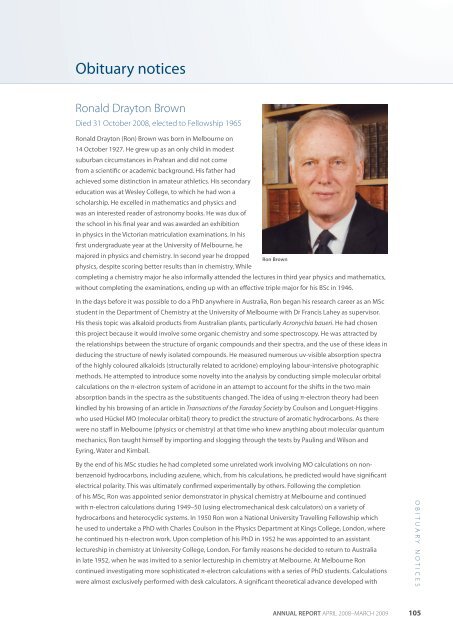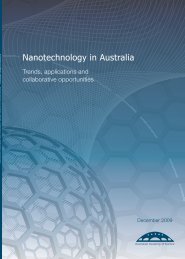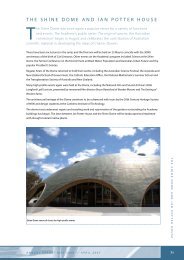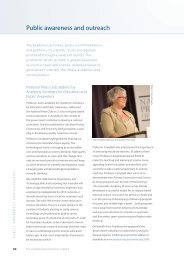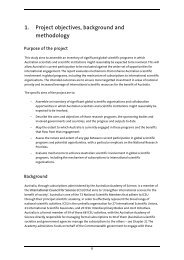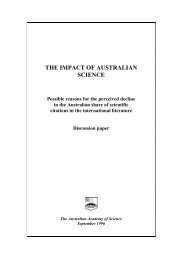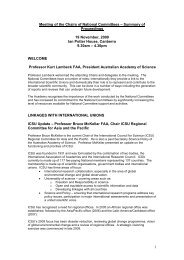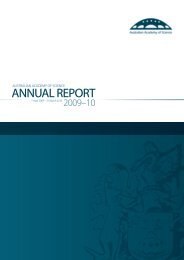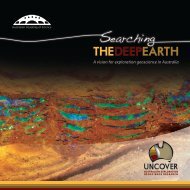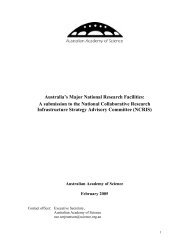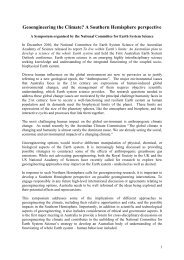full report - Australian Academy of Science
full report - Australian Academy of Science
full report - Australian Academy of Science
Create successful ePaper yourself
Turn your PDF publications into a flip-book with our unique Google optimized e-Paper software.
Obituary notices<br />
Ronald Drayton Brown<br />
Died 31 October 2008, elected to Fellowship 1965<br />
Ronald Drayton (Ron) Brown was born in Melbourne on<br />
14 October 1927. He grew up as an only child in modest<br />
suburban circumstances in Prahran and did not come<br />
from a scientific or academic background. His father had<br />
achieved some distinction in amateur athletics. His secondary<br />
education was at Wesley College, to which he had won a<br />
scholarship. He excelled in mathematics and physics and<br />
was an interested reader <strong>of</strong> astronomy books. He was dux <strong>of</strong><br />
the school in his final year and was awarded an exhibition<br />
in physics in the Victorian matriculation examinations. In his<br />
first undergraduate year at the University <strong>of</strong> Melbourne, he<br />
majored in physics and chemistry. In second year he dropped<br />
physics, despite scoring better results than in chemistry. While<br />
Ron Brown<br />
completing a chemistry major he also informally attended the lectures in third year physics and mathematics,<br />
without completing the examinations, ending up with an effective triple major for his BSc in 1946.<br />
In the days before it was possible to do a PhD anywhere in Australia, Ron began his research career as an MSc<br />
student in the Department <strong>of</strong> Chemistry at the University <strong>of</strong> Melbourne with Dr Francis Lahey as supervisor.<br />
His thesis topic was alkaloid products from <strong>Australian</strong> plants, particularly Acronychia baueri. He had chosen<br />
this project because it would involve some organic chemistry and some spectroscopy. He was attracted by<br />
the relationships between the structure <strong>of</strong> organic compounds and their spectra, and the use <strong>of</strong> these ideas in<br />
deducing the structure <strong>of</strong> newly isolated compounds. He measured numerous uv-visible absorption spectra<br />
<strong>of</strong> the highly coloured alkaloids (structurally related to acridone) employing labour-intensive photographic<br />
methods. He attempted to introduce some novelty into the analysis by conducting simple molecular orbital<br />
calculations on the π-electron system <strong>of</strong> acridone in an attempt to account for the shifts in the two main<br />
absorption bands in the spectra as the substituents changed. The idea <strong>of</strong> using π-electron theory had been<br />
kindled by his browsing <strong>of</strong> an article in Transactions <strong>of</strong> the Faraday Society by Coulson and Longuet-Higgins<br />
who used Hückel MO (molecular orbital) theory to predict the structure <strong>of</strong> aromatic hydrocarbons. As there<br />
were no staff in Melbourne (physics or chemistry) at that time who knew anything about molecular quantum<br />
mechanics, Ron taught himself by importing and slogging through the texts by Pauling and Wilson and<br />
Eyring, Water and Kimball.<br />
By the end <strong>of</strong> his MSc studies he had completed some unrelated work involving MO calculations on nonbenzenoid<br />
hydrocarbons, including azulene, which, from his calculations, he predicted would have significant<br />
electrical polarity. This was ultimately confirmed experimentally by others. Following the completion<br />
<strong>of</strong> his MSc, Ron was appointed senior demonstrator in physical chemistry at Melbourne and continued<br />
with π-electron calculations during 1949–50 (using electromechanical desk calculators) on a variety <strong>of</strong><br />
hydrocarbons and heterocyclic systems. In 1950 Ron won a National University Travelling Fellowship which<br />
he used to undertake a PhD with Charles Coulson in the Physics Department at Kings College, London, where<br />
he continued his π-electron work. Upon completion <strong>of</strong> his PhD in 1952 he was appointed to an assistant<br />
lectureship in chemistry at University College, London. For family reasons he decided to return to Australia<br />
in late 1952, when he was invited to a senior lectureship in chemistry at Melbourne. At Melbourne Ron<br />
continued investigating more sophisticated π-electron calculations with a series <strong>of</strong> PhD students. Calculations<br />
were almost exclusively performed with desk calculators. A significant theoretical advance developed with<br />
OBITUARY NOTICES<br />
ANNUAL REPORT APRIL 2008–MARCH 2009 105


